Does the click end the behavior?
It seems straightforward: we click to mark a desired behavior, and then we reinforce. The act of reinforcing the behavior necessitates a change in action: the horse eats the treat, the dog plays with its favorite toy, and the animal in the process of being reinforced no longer performs the behavior for which it was clicked. The click, therefore, ends the behavior. The phrase has become a widely-repeated tenet of clicker training.
Yet, is it true? The more a trainer explores the use of the clicker, the more he or she may begin to question this principle. After all, if you only click at the end of a behavior, are you also reinforcing "stop working"? How do we use an event marker if we wish the animal to keep going until it is cued to stop working?
Often when we find ourselves in these gray areas, we discover that the question we are asking is the wrong question. Rather than asking "Does the click end the behavior?" we need to ask "Is the click followed by a reinforcer?"
Karen Pryor explains: "In shaping new behavior, we often use the click to say ‘That's what I want, and I'm going to pay you for that.' It's true that the animal does stop what it's doing to collect its treat. Then, however, it repeats the behavior in order to get another treat. So, yes, the click ends the behavior. But it also promotes repetition of the behavior. Once the behavior has been repeated to the point of being learned, and is on cue and being performed with confidence, we don't really need to mark it any more. We can use words or gestures to either signal for more behavior or to signal a halt, depending on what we want.
Can the click carry two meanings?: 1) yes, that is the behavior I want, and 2) please continue doing the behavior. Can it be both an event marker and a keep-going signal? Karen responds: "If you switch the click from being a marker signal to being a kind of encouragement or 'keep going' signal, you are going to be in trouble. When you give random clicks during a continuing behavior (while training a "stay" for example), unpaired with any other event, you separate the click from the reinforcer." Studies at the University of North Texas have demonstrated that to maintain the strength of the association of the click with the reinforcer, you need to keep those two items paired and associated in real time as much as possible, or the power of the click will be reduced until it is meaningless to the animal.
Sometimes, people click and also treat repeatedly during a long-duration behavior, but don't let the behavior stop. In this case the click continues to be paired with the reinforcer, but the click actually has no information in it at all, since it is not marking a clearly identifiable behavior. You have eliminated its main purpose, as a marker signal.
So, if the click must be maintained as an event marker, rather than a keep-going signal, and we don't want to click until the behavior ends, how do we build enduring behaviors?
For horse trainer Alexandra Kurland, the click always ends the behavior: but only temporarily. She writes, "Suppose your horse blasts forward into his usual fast trot, but then has a moment where the trot steadies and slows down. You click, and he stops. He stops BECAUSE the click marks the end of a unit of behavior. If he's going to collect his ‘paycheck,' it has to. So, now you pick up the trot again. The horse rushes off, but he's a clicker-wise animal. He knows he was just reinforced for something. He just doesn't know what. His trot steadies again, just for an instant, but that's all you need to click and say ‘Yes- that's what I wanted.' The horse stops, collects his paycheck, and then starts up again. Eating is relaxing, so the next time he picks up a trot, he's much calmer. Click! You mark that right away and give him a jackpot of a special goody. He's starting to figure out that trotting off slowly turns you into a vending machine. Once he's going into the trot calmly, you can begin to withhold the click and ask for a little more and then a little more." In other words, you build duration the way you would shape up any other behavior: in small increments.
Joan Orr is familiar with this issue too. "People keep asking me if click ends the behavior. Of course it does—how else can it be? In my case, I rely heavily on this concept since I am training on crutches. I have to physically stop to give the treat since I cannot walk and treat at the same time. Because the dog understands that the click means ‘That was right and now it's over,' I don't have a dog that heels by taking a few steps and stopping over. I have a smooth heeling dog even though I have stopped her after 2 steps and 4 steps and 1 step and 5 steps, etc. I don't get why people think otherwise or how they apply this effectively in their training. Someone else told me that they teach ‘stay' by clicking and treating several times intermittently during the stay and then release with a verbal cue. They reset the dog if it gets up after one of these mid-stay clicks. What is a poor dog to do? In this case the click means absolutely nothing."
What do you do if you need to reinforce a particularly good moment inside a long chain of behaviors? One answer lies in our choice of reinforcer. Food is not the only reinforcer, after all. Another known cue for a favorite behavior can also be a reinforcer. On the agility field, for example, a trainer may use the click within an ongoing behavior chain to identify a correct action, such as hitting the contact zone. Karen explains, "You don't want the animal to stop, and you don't want the click to go unreinforced, but of course you have a long-distance reinforcer ready to hand, namely, the cue for the next action. So if you follow the click or pair the click instantly with another known cue, you have identified a desired move with the click." You can reinforce a desired behavior with another cue, thereby maintaining the conditioned association of click with a reinforcer, in this case another cue.
This reward is very powerful for Joan Orr's dog Josie. "She likes the ‘away' cue even better than food or toys," says Joan. "It's a very strong conditioned reinforcer and I can use it to reinforce other behavior and still keep her moving fast and not looking at me."
Marking a correct behavior without stopping the action can also be paired with physical cues that tell the animal to keep going. Back to the agility field: if a trainer is after correct form on the broad jump, she might click a good take-off. Then the dog is in the air, and the jump has to be finished anyway. In training the weave poles, the poles themselves can become cues to tell the dog to keep going; physical objects quickly become learned visual cues. (Too quickly, in fact as we must often teach that verbal cues override visual cues: "Don't just jump everything in front of you, listen to me instead!")
Mostly people fall into the trap of thinking they have to click "during" a behavior, once or many times, because they don't understand that the way to build a long-duration behavior is to gradually increase the length of time you are asking for; and click only at the end of that length of time. Duration, in other words, is a separate behavior from the one you are training, and it must be shaped just as any other behavior is shaped. For very clear, step-by-step instructions on clicker training for long-duration behaviors. see Morgan Spector's Clicker Training for Obedience.




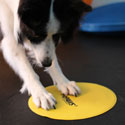
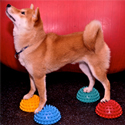
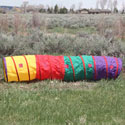
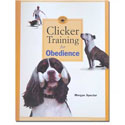
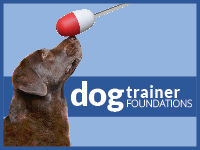


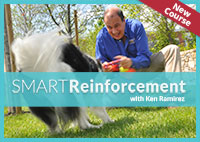

Post new comment